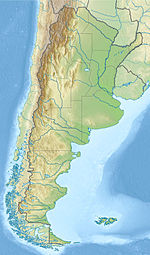- Mburucuyá National Park
-
Mburucuyá National Park Parque Nacional Mburucuyá Location Corrientes Province, Argentina Coordinates 28°1′S 58°1′W / 28.017°S 58.017°WCoordinates: 28°1′S 58°1′W / 28.017°S 58.017°W Area 17.660 hectares Established 2001 Mburucuyá National Park (Spanish: Parque Nacional Mburucuyá) is a National park in Argentina. It is located in the north west of the Corrientes Province around 150 km from the city of Corrientes and covers an area of 176 square kilometres of the Iberá Wetlands.
The area is important for the provision of water, the regulation of floods and draughts in the local region through its effects on the regional microclimate.
Contents
History
Around 5,000 years ago the area was populated by indigenous peoples, in more recent times the area was occupied by the Guaraní who introduced the cultivation of maize, squash, beans, Cassava, cotton and yerba mate.
When the territory was colonized by the Spanish many of the original settlements were occupied and substantially modified. The introduction of large scale agriculture saw the indescriminate deforestation of native trees.
The creation of the national park occurred in the 20th century. After the 2nd World War Dr. Troels Pederson donated the territory for the creation of the national park. The objectives of the park are to maintain the environment and show the region in its historical context.
Natural resources
The zone is divided between three distinct natural regions chaqueña, espinal and selva paranaense.
Chaco Oriental
Composed of woodland, palms, grass plains and wetlands. Some characteristic native species are quebracho (quebracho colorado and quebraco blanco) urunday and viraró, prosopis, palms and caranday.
Selva Paranaense
The area is characterised by small hills, local species include the syagrus romanzoffiana palm timbó and laurel.
El Espinal
The region is populated with yatay palms, poaceae and diverse xerophile woodland.
Fauna
The park has around 150 species of birds, and many species of animal including capybara, caymen, foxes armadillos jaguars and brown howler monkeys. Endangered species include maned wolf neotropical river otter and marsh deer.
Native fish species include golden dorado and pseudoplatystoma
National Parks of Argentina by region Northwest Chaqueña | Mesopotamia Cuyo | Pampas San Guillermo · Talampaya · El Leoncito · Sierra de las Quijadas | Quebrada del Condorito · Lihué Calel · Predelta · Campos del Tuyú · Islas de Santa FePatagonia Laguna Blanca · Lanín · Los Arrayanes · Nahuel Huapi · Lago Puelo · Los Alerces · Perito Moreno · Los Glaciares · Monte León · Tierra del Fuegobold indicate a UNESCO World Heritage Site Categories:- IUCN Category II
- National parks of Argentina
- Corrientes Province
Wikimedia Foundation. 2010.

